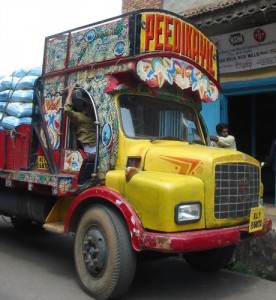 Neben den kleinen Fahrzeugen gibt es aber auch große, weniger in der Städten, aber für den Warentransport über Land.
Neben den kleinen Fahrzeugen gibt es aber auch große, weniger in der Städten, aber für den Warentransport über Land.
(Die nächsten Bilder stammen aus Fort Cochin in Kerala, aus einer Marktstraße die vor allem von Großhändlern für Gewürze, Tee und Reis gesäumt wird.)
Dies ist, so könnte man sagen, “Tuning” auf indisch. 😉
Die LKW mögen alt sein, die Technik schwach, Sicherheitsaspekte vernachlässigbar… aber schön müssen sie sein. Die Malereien sind oft detailiert, die bemalten Flächen groß.
Noch beeindruckender, um nicht zu sagen von schrecklicher Schönheit ist so ein Ding allerdings, wenn es einem auf der Überholspur des Highways (ja, so was gibt es in Indien, nicht ganz so aufs Rasen ausgelegt wie eine deutsche Autobahn, aber es gibt mehrspurige Schnellstraßen mit getrennten Richtungsfahrbahnen) entgegen kommt.
Wie gesagt, das mit den Verkehrsegeln ist so eine Sache… wer größer ist hat Recht. Und wer kleiner ist besteht besser nicht auf seinem. Falls die Bremse doch nicht so gut ist, wie der Fahrer gedacht hatte. Oder die Ladung schwerer. Oder so.
Auch die Namen über der Frontscheibe tragen nicht gerade zur Beruhigung bei. Oft handelt es sich (so weit ich das beurteilen kann) um Götter, “Lakshmi”, “Ganesha”, “Krishna” habe ich gesehen, aber auch “Lord”,” Jesus” oder “Matha Maria” (immerhin phonetisch kommts hin – mit indischer Aussprache).
Himmlischer Schutz ist sicher nützlich. Und nachts zu fahren sollte man vermeiden, denn Busse und LKW, aber auch viele Auto-Rikschas sind bestenfalls vorne beleuchtet. Hinten guckt ja keiner raus, wozu also Licht? – Genau.
The small ones dominate the city, but the goods carriers outside are huge. And kind of “indien pimped”. 😉
(Next pictures were taken in Fort Cochin in a Bazaar street, dominated bei wholesalers for spice, tea or rice.)
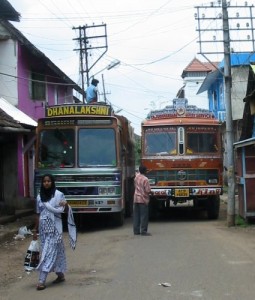 Technique of the truck may not be the main issue, it can be old, rusty, engine hardly functionning at all. But it must be colourful. The trucks are big, painted with a lot of love for small details.
Technique of the truck may not be the main issue, it can be old, rusty, engine hardly functionning at all. But it must be colourful. The trucks are big, painted with a lot of love for small details.
Even more impressive, not to say slightly (…) scary becomes such a colossus when you face it on the fast lane of a highway running in the wrong direction. (Yes, India has a few highways which are quite okay to use.)
One basic traffic rule is, that the bigger guy is right. And the smaller better not tries to get it’s right immediately. You can see that the trucks engine is all right… but what about the brakes…? Who wants to test…?
The names they all have over the windscreen are not really reassuring either. Usually it’s the names of gods or godess (as far as I can tell), I have seen “Lakshmi”, “Ganesha” or “Krishna”, but also “Lord”, “Jesus” or also “Matha Maria” (phonetically correct, if you speek indian english).
Considering the way how people drive a good deal of celestial protection is definitely recommended…
Besides not driving at night is the safer option. (Also if you rent a car with driver, usually the driver is automatically included, when you rent a car, renting it without would be more expensive… the driver will normally make sure, that you and he and his car have arrived before nightfall.) Because headlights are sometimes used by trucks, buses or auto-rikshaes. Rear lights on the contrary… what shoud they bei good for? No one looks out of the rear window…
Also no one is willing to wait.
Overtaking is always possible, even in the smallest lane. (Okay, this one was more like a boulevard, for the local conditions…)
Geduld ist im Übrigen auch keine Stärke indischer Autofahrer. Platz zum Überholen ist immer, auch in der schmalsten Gasse. (Wobei diese Straße für eine indische Provinzstadt eher breit war.)
Auch die Straßen generell sind eine interessante Erfahrung für Europäer.
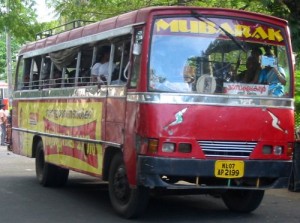 Zum einen gibt es tatsächlich eine Art Autobahn.
Zum einen gibt es tatsächlich eine Art Autobahn.
Oft sind sie zweispurig und die Straßenqualität ist recht gut. Allerdings sind sie nicht kreuzungsfrei. Dörfer oder Städte die direkt an der Straße liegen sorgen für menschliches und tierisches Gewusel, natürlich auch für Busse die anhalten, Gepäck und Passagiere auf oder wieder abladen, am besten gleich auf der Fahrbahn, runter fahren wäre mühsam.
Da die linke (Indien hat Linksverkehr) Fahrbahn somit nicht unbedingt frei befahrbar ist, halten sich auch langsame LKW oder Busse lieber an die Überholspur. PKW müssen eben zusehen, wie sie durchkommen, Motorräder und Autorikschas ohnehin.
Und wenn der Bauer ins nächste Dorf will, fährt auch der Ochsenkarren über den Highway.
Manche Autobahnen haben sogar einen schön bepflanzten Mittelstreifen. Geradezu perfekt um Kühe darauf weiden zu lassen.
Und ist man zu weit gefahren? Kein Problem, der Mittelstreifen ist durchbrochen, damit man wenden kann. So braucht man auch nur auf einer Seite eine Raststätte…
Immerhin, auf eine mittlere Geschwindigkeit von 70 Kilometern in der Stunde kann man kommen. Auf dem Highway, wohl gemerkt. Andere Straßen können alles sein, von halbwegs lochlosem Asphalt bis hin zur Schlammpiste.
From a European point of view the streets are enother interesting experience.
Yes, there are highways. They have at least two lanes for each direction and the quality of the street is reasonably good, you can speed up.
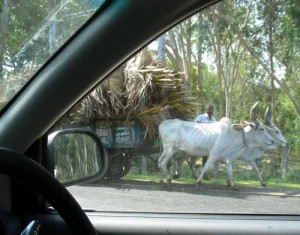 Unless you come to the next smaller city oder village that will be directely next to the street. People and animals run around, markets are held, the buses stop… and as the quality of the street is muchbetter on the highway than next to it, the buses my even stop on the highway, beeing more convenient. For the bus driver.
Unless you come to the next smaller city oder village that will be directely next to the street. People and animals run around, markets are held, the buses stop… and as the quality of the street is muchbetter on the highway than next to it, the buses my even stop on the highway, beeing more convenient. For the bus driver.
As the left lane is thus from time to time blocked, everybody preferes the fast lane on the right. Including busses and trucks. So the car drivers and the motorbikes have to manoeuvre around to overtake the slow vehicles. Also autorikshaws, but they are small and not too quick anyhow…
The use of the highways is not limited to motorized vehicles… if a farmer wants to go to the next village with his bullock cart… highways are just fine. And as he will have no driving licence, chances are, that he will choose the fast lane…. in any direction.
Sometimes the lanes in the different directions are separeted by a bit of plants, grass, greenery,… a perfect spot to bring the cattle to graze…
And unlike in European countries if you find, that you went to far… just wait for the next hole in the middle for a U-turn. That’s absolutely legal and permitted.
As a result of all that your over all speed over a longer distance will not exceed 70 km/h. On the highway. Other roads… can be anything from quite straight asphalt to mud and holes.
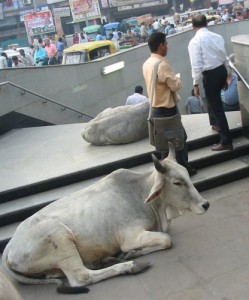 Andererseits gibt es aber auch ganz moderne Massentransportmittel. Delhi hat etwa drei Metrolinien und die funktionieren (zumindest in den drei Tagen, die wir sie genutzt haben) sehr gut.
Andererseits gibt es aber auch ganz moderne Massentransportmittel. Delhi hat etwa drei Metrolinien und die funktionieren (zumindest in den drei Tagen, die wir sie genutzt haben) sehr gut.
Bis auf gelegentliche kleine Hindernisse am Metroeingang… 😉
Lustig ist allerdings das Verhalten der Einheimischen… öffnen sich die Türen der Metro stürmen alle hinein. Ohne das geringste Verständnis dafür, daß sie gar nicht rein können, bevor diejenigen, die schon drin sind, rausgekommen sind.
Wer glaubt, das sei bei deutschen Zügen genauso… ne, Deutsche sind oberdiszipliniert und höflich im Vergleich dazu. Wir lassen wenigstens eine zehn Zentimeter breite Gasse zum Aussteigen… statt in voller Breitseite reinzustürmen.
Aber wenn man mal drin ist (oder wieder draußen..) funktioniert das System gut. Moderner als die Kölner Straßenbahn…
On the other side there are cool, modern means of transport, who works just fine. (At least the Delhi Metro did work fine in the three days we spent at Delhi.)
Except for some minor obstacles at an entrance… 🙂
Another strange thing is the behaviour of the locals… the train stops, the doors opben and first thing is, that everybody tries to get in at the same time. Without any understanding of the fact, that people have to be out, before other people can get in.
Before I thought, that people in Germany show this stupid behaviour, but no comparison! In Germany (or even in France) they will let at least a 10cm large lane to get out… Indians try to get in at full door largeness.
But once you are in (or out) the system works fine. And much more modern than the Cologne “Straßenbahn”.
